Beef Tamales
Beef tamales are part of Mexican tradition — layered with flavor, made with care, and filled with memories that last. It’s a simple, meaningful process that brings families together and fills the home with comforting flavors.

It all starts with the filling: the beef is cooked until tender and melt-in-your-mouth soft, then soaked in a rich red chile sauce made from some of Mexico’s finest dried peppers. The masa comes together in a stand mixer, combining lard, oil, broth, and a touch of the red sauce to create a soft, smooth, and flavorful dough.
Finally, the tamales are wrapped in flexible, soaked corn husks — almost like wrapping little gifts to be unwrapped at the table. A snug steamer pot holds them close as they cook, transforming into a dish that’s tender, delicious, and deeply comforting.

What are Tamales?
Tamales are a traditional Mexican dish made from masa (corn dough) filled with saucy meats or cheese, then wrapped in corn husks or banana leaves and steamed to perfection. Their origins date back thousands of years to the Aztec and Maya civilizations, where they were portable meals for warriors and travelers.
Across Mexico, tamales vary widely by region and ingredients. In the north, beef or pork with red chile sauces are popular, while southern states favor chicken, mole, or even sweet fillings. Oaxaca is famous for tamales wrapped in banana leaves, giving a unique aroma and flavor, whereas central Mexico often sticks to corn husks.
Every region has its own traditional recipes, reflecting local ingredients, history, and celebrations.
Ingredients
- Beef Chuck Roast – Rich and marbled, this cut creates a deeply flavorful broth and tender meat.
- White Onion and Garlic – a perfect pair that adds mild sweetness and cozy warmth.
- Oregano, Allspice, and Bay Leaves – Combine to create a fragrant, well-balanced broth with earthy, citrusy, and gently spiced notes.
- Guajillo, Ancho, and Puya Chiles – This trio gives the sauce its deep red color and complex flavor, balancing mild fruitiness, smoky sweetness, and a hint of heat.
- Cumin Seeds – Bring natural sweetness and earthy, aromatic depth, tying together the flavors of the sauce.
- Instant Corn Masa Harina – The foundation of every tamal, delivering that unmistakable corn flavor.
- Baking Powder – Lightens the masa, creating a soft and tender texture.
- Lard – Whipped until fluffy, it adds richness and moisture, producing a melt-in-your-mouth masa.
- Avocado Oil – Works together with lard, balancing the flavors and providing enough fat to lock in moisture.
- Corn Husks – Used traditionally for wrapping tamales, they provide a gentle aroma and an authentic tamal presentation.

How to Make Beef Tamales
Here’s a quick rundown of the main steps. For full, step-by-step instructions, check out the recipe card.
Step 1: Prep the Meat
Pat and season the beef, then sear it in the Instant Pot. Add aromatics and water, cook on High Pressure until tender. Skim off excess fat, shred the beef, and strain the broth—reserve both for later.
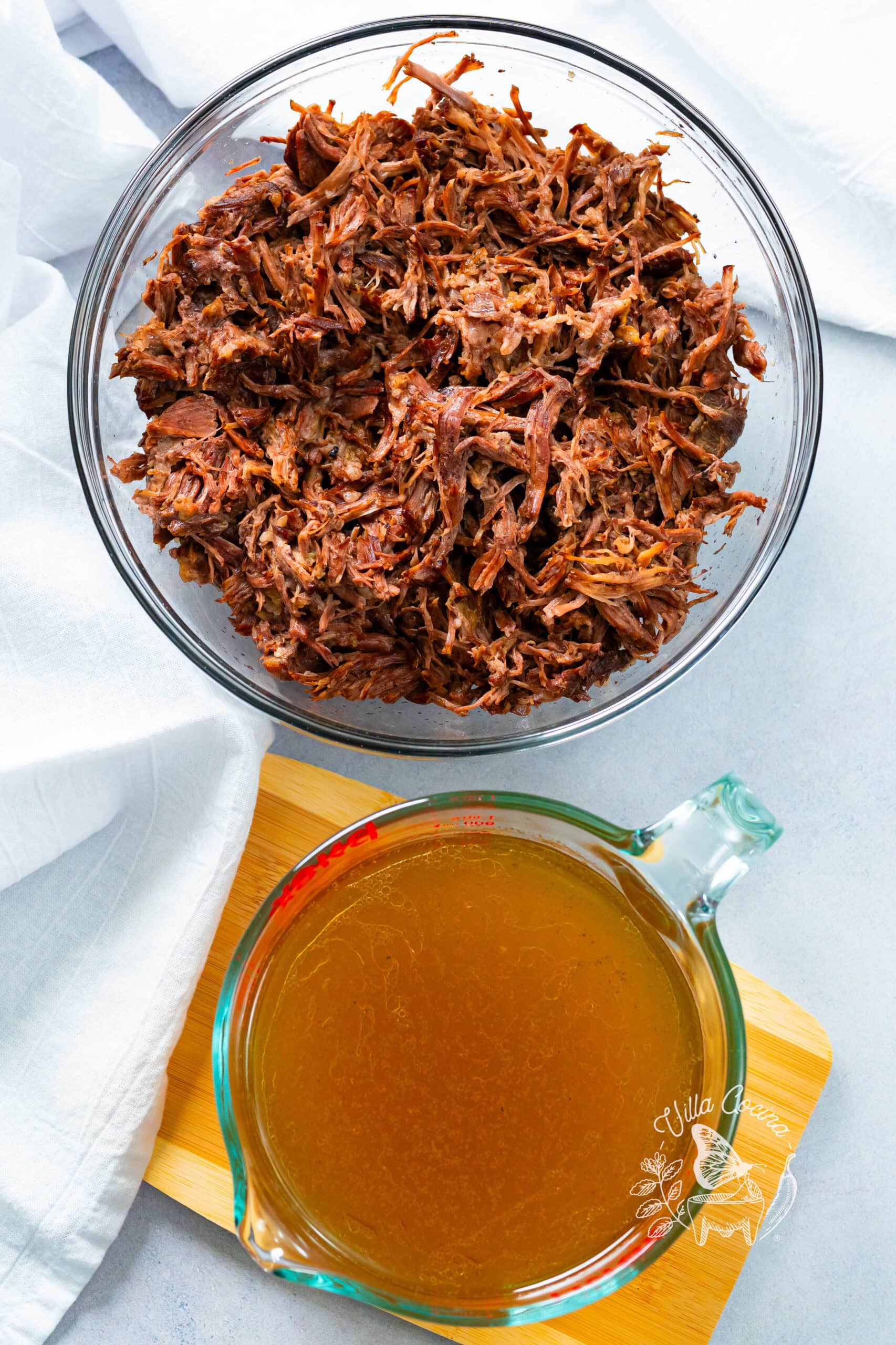
Step 2: Hydrate the Peppers & Make the Sauce
For the sauce, lightly cook and toast the onions, garlic, spices, and chiles. Soak them in broth until soft, then blend into a smooth red sauce. Reserve a portion for the masa.

Step 3: Cook the Filling
Sauté the oil, then add the chile sauce and let it reduce slightly to deepen in color. Stir in the shredded beef, cook until heated and well-coated, season to taste, and set aside to cool.

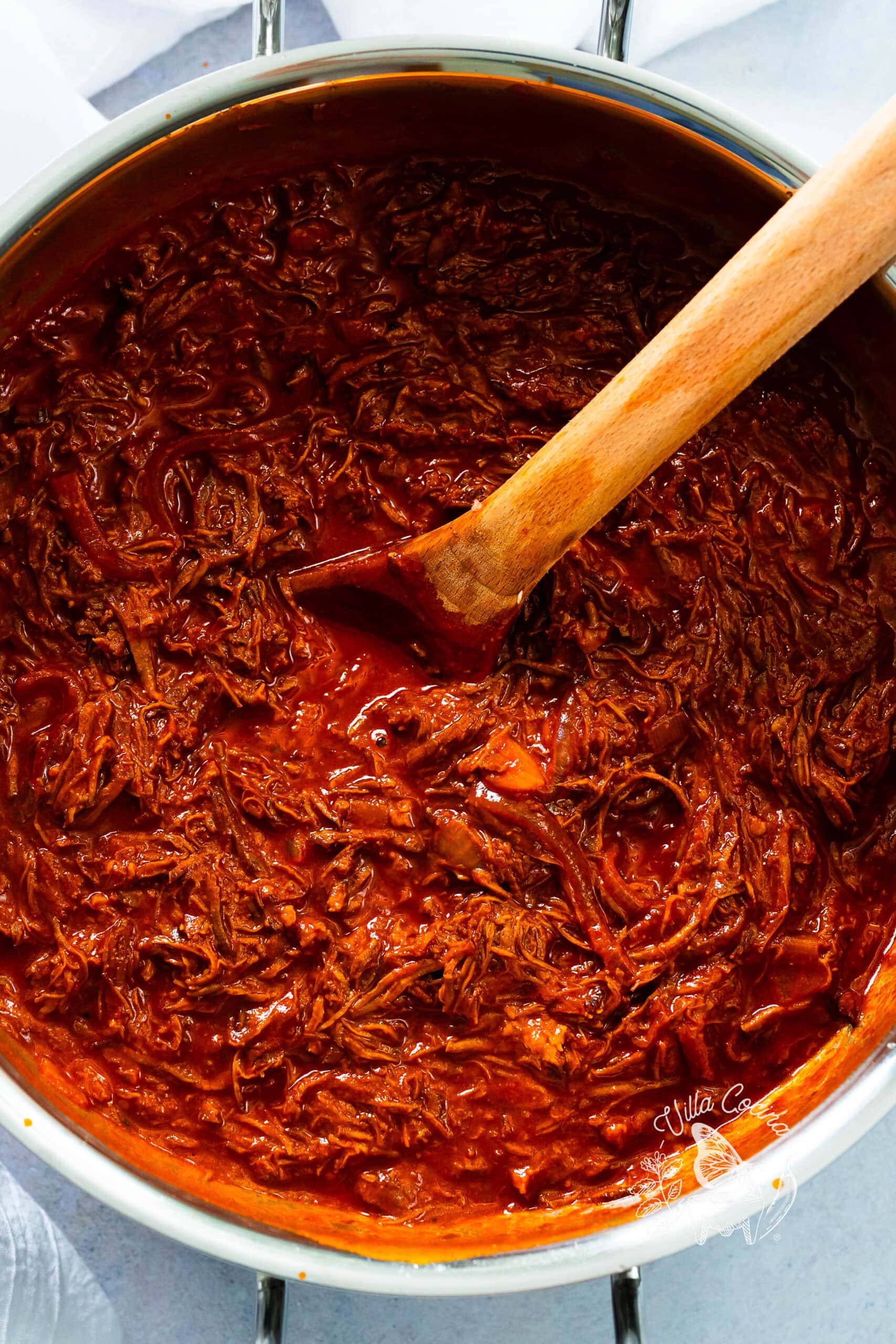
Step 4: Prepare the Corn Husks
Sort the husks, soak until pliable, then rinse and pat dry to remove excess water. Set aside any imperfect husks for lining the steamer and covering the tamales.

Step 5: Make the Masa
Beat lard until fluffy. Gradually add the masa, avocado oil, reserved red sauce, and warm broth until soft, smooth, and spreadable. Adjust salt and moisture as needed.

Step 6: Assemble the Tamales
Spread masa evenly on the smooth side of each husk. Add a generous portion of beef filling down the center. Fold the sides over the filling and seal, then fold and roll tightly.
Fold the narrow top downward, tucking the flap underneath to secure it. Place each finished tamal on a tray and repeat with the remaining husks.

Step 7: Steam the Tamales
Add water to the steamer pot, keeping it just below the rack. Line the rack with extra husks, then arrange the tamales in pairs, back-to-back, with the flaps facing each other. Cover with remaining husks and steam on medium-low for 75–90 minutes, adding more water as needed to maintain the level.

Step 8: Test and Serve
Remove one tamale and let it rest for 10–15 minutes. It should release easily from the husk and hold its shape. Serve warm and enjoy!

Recipe Video Tutorial
Watch my easy video tutorial for step-by-step visuals on making Beef Tamales.
Enjoyed the video? Subscribe and tap the bell for updates on new recipes. Thank you for your support!
Why You’ll Love This Recipe
There are so many tamal recipes out there — and it’s no surprise! Mexico alone is home to over 300 varieties, each with its own flavor, texture, and story. And that’s just Mexico — add countries like Guatemala and El Salvador, and the list keeps growing.
I’ve tried many versions myself, but here’s why I truly love this one (and I think you will too):
- The beef is deeply browned to build rich flavor, creating a more colorful broth that reflects that depth. The meat then simmers until tender and soaks in a red sauce where the chiles have been carefully chosen and lightly toasted to release their natural oils.
- No bought broth needed — every ingredient plays its part. Instead, the homemade broth from the meat cooking becomes the foundation for both filling and masa, connecting every layer of the dish.
- The masa turns out soft, tender, and perfectly moist — thanks to a mix of lard and oil that locks in moisture and prevents dryness. It spreads easily, making assembly simple and satisfying.
Equipment Needed
Here’s a short list of equipment that makes the tamale process easier — plus alternatives if you don’t have the exact tool on hand.
- Instant Pot: Cooks the beef quickly and easily. If you don’t have one, stovetop instructions are included below in this article—use the table of contents for a quick reference.
- Stand Mixer: Makes mixing the masa much faster and easier. A regular electric hand mixer works too.
- Flexible Spatula: Use a flexible spatula or a bench scraper to spread the masa evenly and smoothly.
- Steamer Pot: Whether it’s a traditional Mexican steamer, a pot with a rack, or a steamer basket, make sure it’s large enough to hold the tamales standing up with a lid to trap the steam.
Ingredient Suggestions
I get a lot of questions about a few key ingredients, so here’s where I source mine and what works best.
- Masa Harina: I recommend using high-quality masa since each ingredient matters in this recipe. My favorite is Masienda white corn masa, available online or at Whole Foods.
- King Arthur’s organic masa used to be my go-to, but it’s been discontinued. Maseca works in a pinch, though it’s not my top choice.
- Lard: Good-quality lard really boosts flavor. Avoid hydrogenated lard—it’s lacking in taste. I prefer pasture-raised lard from FatWorks, or beef tallow if you want a twist.
- Make sure the lard is solid white and chilled before beating. You can also try rendering your own—[My Recipe Link].
- Mexican Dried Chiles: Your local Mexican store is ideal, but Amazon has good options too. I use guajillo, ancho, and puya chiles.
- Corn Husks: Again, Mexican stores usually have the best selection, but they’re also available online.
Stovetop Instructions for Cooking the Meat:
- Place a large pot over medium-high heat and heat the oil. Brown the meat on all sides. Pour in the water, and if you removed any meat earlier, return it to the pot. Add all the aromatics for the broth.
- Bring to a boil, skim off any impurities, then reduce the heat to medium-low and simmer gently for about 2½ hours, or until the meat is very tender. Before removing the meat, remove any excess fat. Remove and shred the beef and strain the broth, reserving both for later use.
Tips for Perfect Beef Tamales
- Why so many husks?
You’ll usually need more corn husks than the number of tamales. Only medium to large husks work best.
If a tamal doesn’t seem fully covered, wrap an extra husk around it to keep it secure during steaming. Use any imperfect leaves to line the steamer rack and cover the tamales.
- Heat level and peppers
When making the sauce, the puya chile holds the most heat. Keep the seeds for a spicier tamal, or remove them—or substitute for 1–2 guajillos—for a milder flavor.
- Toasting peppers
Toast them just until fragrant, turning continuously and lowering the heat if needed. Burnt peppers taste bitter and can ruin the sauce.
- Fat Combination
Using both lard and oil creates a smooth, tender, and flavorful masa. This tip was passed down from my mother and really helps achieve a balanced flavor.
- Masa consistency
Stop adding broth once the masa reaches the right consistency—the amount may vary depending on the broth’s temperature or the brand of masa.
If the masa feels too firm, add a splash of warm broth or water. Keep in mind that broth is lightly salted and may alter the seasoning slightly, while water is a neutral option.
- Spreading the Masa
Always use the smooth side of the corn husk when spreading the masa. A flexible spatula works best, but a bench scraper is a good alternative.
- Extra Masa?
If you run out of filling but still have extra masa, add a layer of sliced queso fresco, shredded Oaxaca, or mozzarella, and optionally some pickled jalapeños for an extra kick.
- Boiling water
You can bring the water to a boil either while arranging the tamales in the steamer or after they’re in place. Start timing once the water reaches a boil, and be careful of the steam.
Pairings for Your Tamales
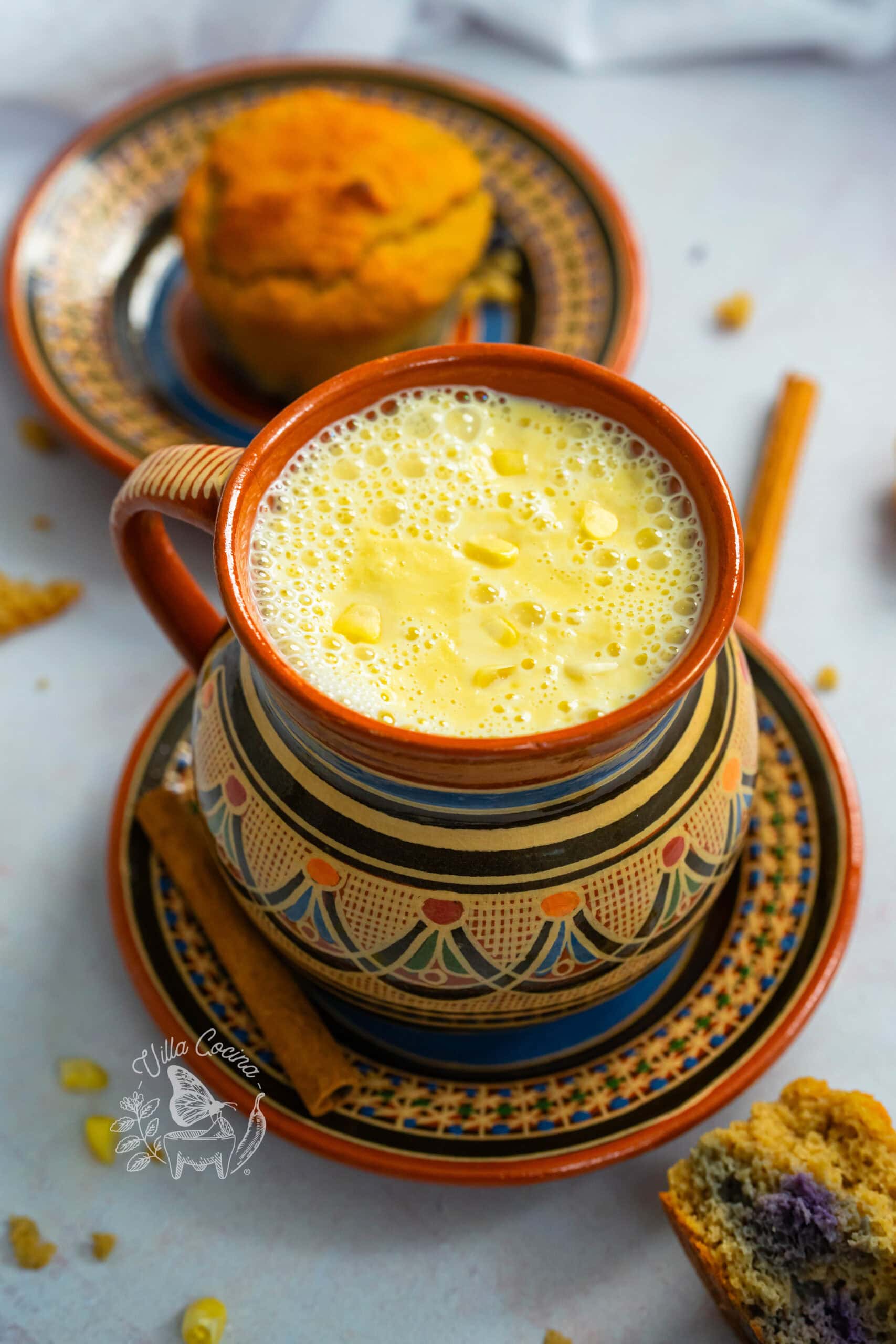

Store
Refrigeration: Store tamales in airtight containers or Ziploc bags for 3–4 days.
Freezing: Let tamales cool completely, then place them in freezer-safe bags with the husks on. Remove as much air as possible, label with the date, and freeze for up to 3 months.
Reheating: Thaw tamales in the refrigerator overnight, then steam, heat on a comal, or microwave until warmed through. Watch the video tutorial below for a more in-depth explanation.
More Tamal Varieties
- Mexican Red Pork Tamales
- Chile Verde Pork Tamales
- Green Chicken Tamales
- Red Chicken Tamales
- Tamale Casserole
- Tamales Rajas Con Queso
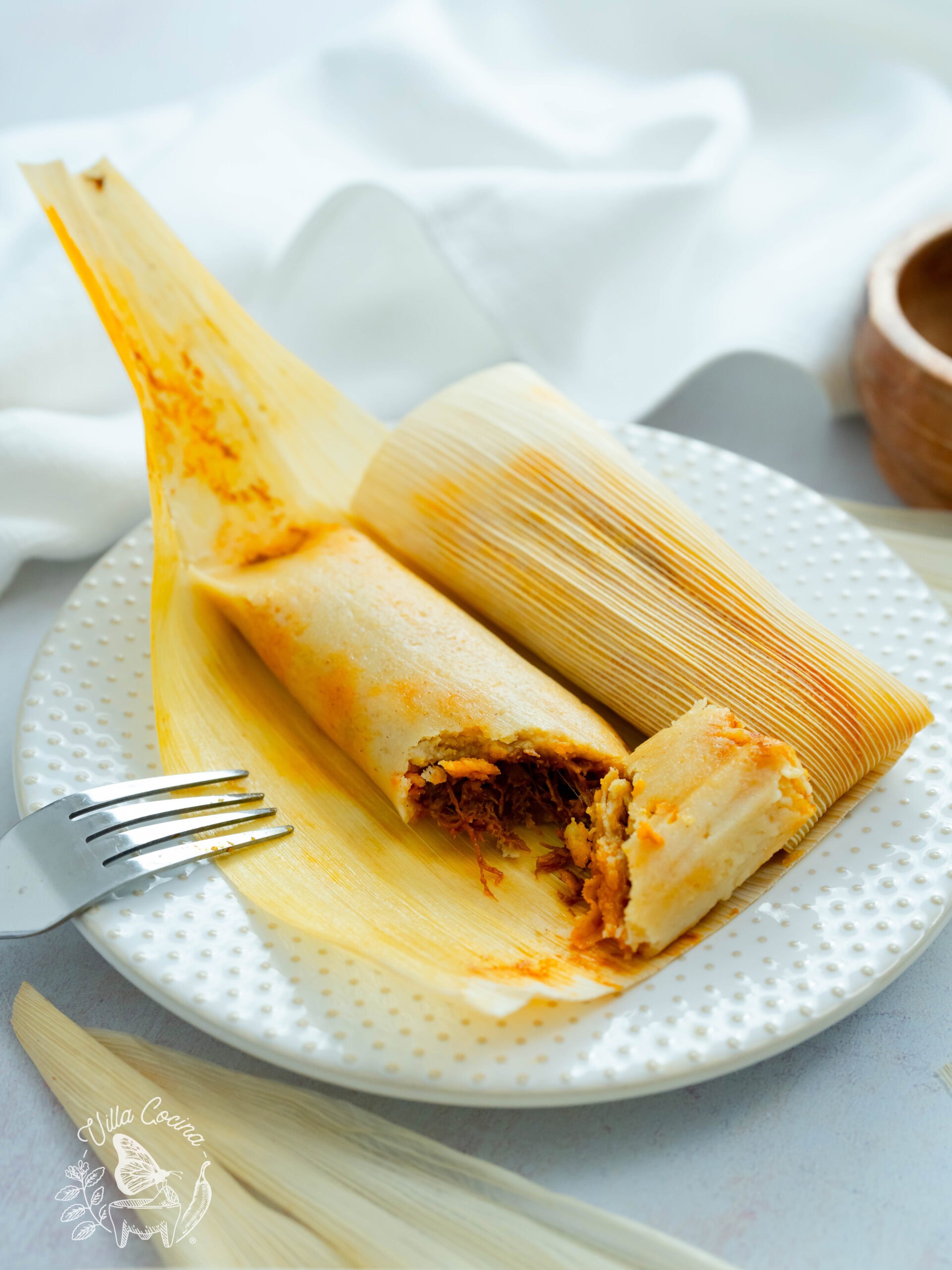
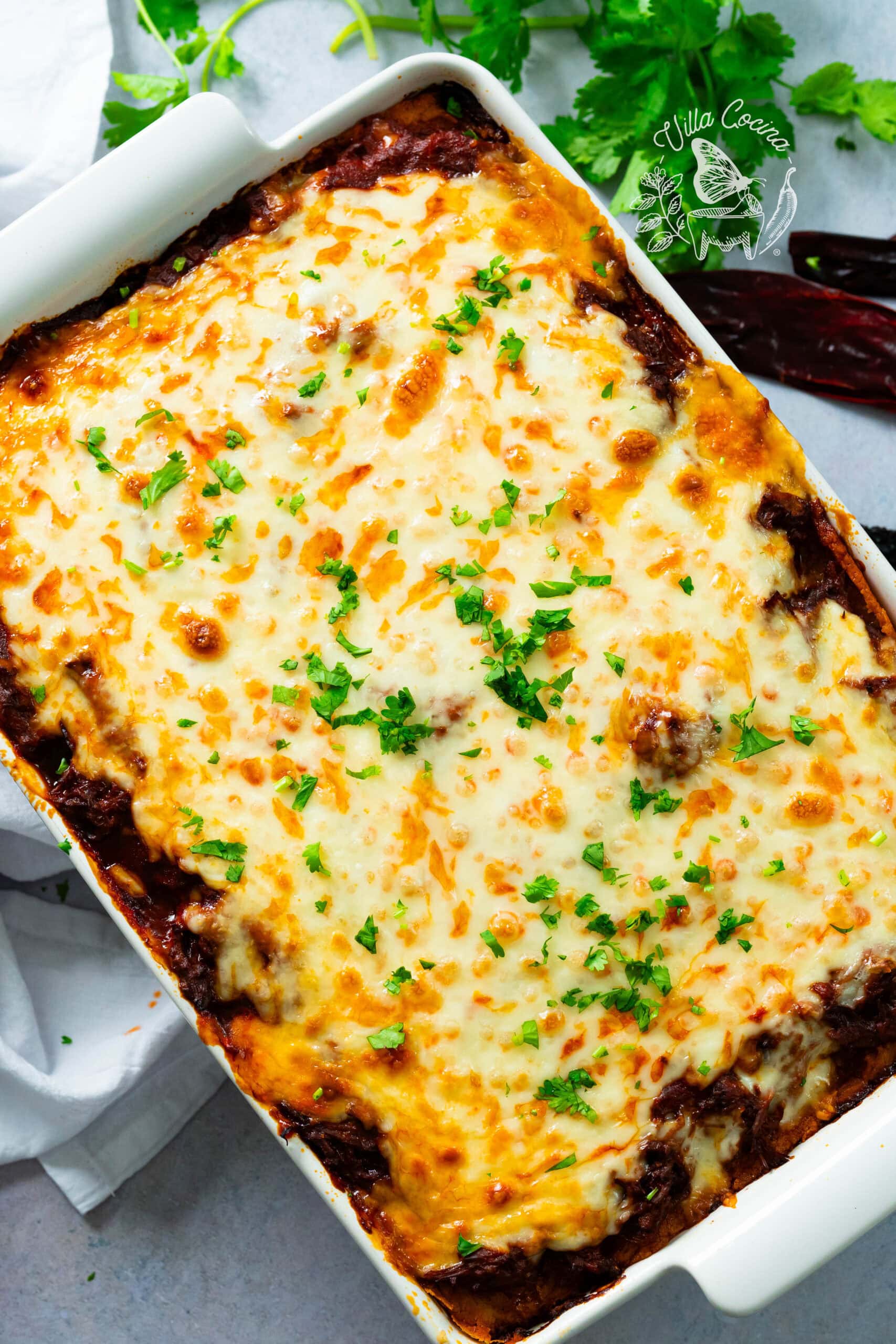
FAQs- Answered
Can the filling be made a day ahead?
Yes, definitely! Just make sure to keep it refrigerated once it cools down. When ready to assemble your tamales, the filling shouldn’t be too cold or too hot — warm it slightly.
How can I tell when the tamales are done steaming?
Remove one tamal from the pot and let it rest for 10–15 minutes. It should release easily from the husk, hold its shape, and taste fully cooked.
Can I use another type of meat for the filling?
Absolutely! Pork, chicken, or even shredded turkey work great with the same sauce and seasoning base. Just keep in mind that cooking times may vary depending on the protein and cooking method.
What if my masa feels too dry?
Add a bit of warm broth or water, one tablespoon at a time, until the dough feels soft, smooth, and spreadable. If you’ve already adjusted the salt, keep in mind that broth may slightly change the seasoning — water is a good neutral option if needed.
Can I make the masa ahead of time?
I don’t recommend it — refrigeration can slightly change its consistency. Instead, prep your ingredients ahead so the next day you can simply mix everything together. It really is that simple!

Beef Tamales
Ingredients
Cook the Meat
- 4 lbs boneless beef chuck roast
- Liberally kosher salt
- Liberally ground black pepper
- 12 cup water
- ½ white onion
- 1 head garlic, slice end off
- 1 tsp dried Mexican oregano
- 1 tsp whole allspice
- 3 bay leaves
Red Sauce
- 12 guajillo chiles, seeded, stemmed
- 2 ancho chiles, seeded, stemmed
- 4 puya chiles, stemmed
- ½ white onion, diced
- 6 garlic cloves, peeled
- 1 tsp dried Mexican oregano
- ½ tsp cumin seeds
- To taste kosher salt
Masa- Dough
- 6 cups instant corn masa harina
- 2½ tsp kosher salt, or to taste
- 1 tbsp baking powder
- 1 cup pork lard
- ½ cup avocado oil
- 1 cup chile sauce
- 4-5 cups warm beef broth
Additional
- 1½ lbs corn husks, about 60
- Avocado oil, as needed
- Pork lard, as needed
- Kosher salt, as needed
Instructions
Prep the Meat
- Pat the beef dry with paper towels, then cut it into large chunks. Season all sides generously with kosher salt and black pepper.
Instant Pot- 8qt
- Set the Instant Pot to Sauté (High). Melt 2 tablespoons of oil and sear the beef until deeply browned.
- Pour in 12 cups of water (without exceeding the Max line), then add the onion, garlic, oregano, allspice, and bay leaves.
- Lock the lid and cook on High Pressure for 45 minutes. Allow the pressure to release naturally for 10 minutes, then manually release any remaining pressure.
Hydrate the Peppers
- Cut the guajillo, puya, and ancho chiles into smaller pieces.
- In a large saucepan, heat 2 tablespoons of lard over medium heat. Sauté the onion and garlic until slightly softened. Add the oregano and cumin, and cook for about 1 minute until fragrant.
- Add the dried chiles and lightly toast for 30 seconds to 1 minute, stirring constantly to prevent burning, until fragrant. Pour in 5 cups of the reserved beef broth and bring to a gentle simmer. Turn off the heat and let the chiles hydrate for 10–15 minutes, or until fully softened.
- Transfer the chile mixture to a blender and blend until completely smooth. Strain if needed to remove any large pieces.
- Reserve 1 cup of the sauce for the masa and set the rest aside for the filling.
Make the Filling
- Heat 1 tablespoon of oil in a large saucepan over medium-low heat.
- Carefully pour in the chile sauce, stirring to combine. Bring it to a gentle simmer and cook for 10–15 minutes, or until the sauce thickens and deepens in color.
- Add the shredded beef and stir until evenly coated. Season with salt to taste, then cook for 2–3 minutes, just until heated through. Remove from heat and let it cool down before assembling the tamales.
Corn Husk Prep
- Sort through the corn husks, choosing medium to large ones without holes or dark spots. Set aside the imperfect husks for lining the steamer or covering the tamales.
- Soak the husks in warm to hot water for 15–30 minutes, or until softened and pliable. Use a plate to keep them submerged.
- Rinse well, removing any remaining corn silk, then drain and pat dry with paper towels.
Make the Masa
- In a large bowl, whisk together the corn masa harina, baking powder, and kosher salt until evenly combined.
- In a stand mixer fitted with the paddle attachment, beat the lard on medium to medium-high speed for 3–5 minutes, until smooth, light, and fluffy. Scrape down the sides and bottom of the bowl.
- Add the dry masa mixture in three portions: For the first addition, pour in ½ cup of avocado oil and a small amount of the warm beef broth to help it come together. Mix on low speed until fully combined.
- Second addition: Add the reserved 1 cup of red sauce, then gradually pour in about 1 cup of broth in a thin, steady stream along the side of the bowl — just enough to keep the mixer running smoothly. The dough will start to loosen as it hydrates.
- Add the last portion of masa, along with a bit more broth. Continue mixing on low speed while gradually pouring in the remaining broth until the dough is soft, smooth, and spreadable, similar to thick hummus. The total amount of broth used for the masa should be about 4–5 cups.
- Stop adding broth once you reach the right consistency — the amount may vary depending on the broth’s temperature or the brand of masa.
- Once the dough feels right, taste and adjust the salt if needed (I added about ½ teaspoon kosher salt). Then mix on medium speed for about 5 minutes until everything is fully combined.
- If the masa ever feels too firm, mix in a splash of warm broth or water. Keep in mind that the broth contains salt.
Assemble the Tamales
- Using the smooth side of a corn husk and a flexible spatula, spread about ⅓ cup to 6 tablespoons of masa in an even layer, depending on how thick you prefer your tamales, leaving space at the wide bottom and along the sides. Spread it slightly past halfway toward the narrow top.
- Spoon a generous amount of filling down the center, leaving room on the sides. Seal the edges by bringing the sides of the husk over the filling, then fold and roll tightly. Fold the narrow top downward, tucking the flap underneath to keep it closed.
- Place the finished tamal on a half sheet pan and repeat with the remaining husks.
Cook the Tamales
- Use a large steamer pot and add enough water to reach just below the rack, making sure it doesn’t touch the tamales. Line the rack with extra corn husks, using imperfect ones if needed.
- Turn the heat to medium-high and begin bringing the water to a boil. Be careful with the steam.
- First, pair two tamales back-to-back with the flaps facing each other to keep them secure and upright. Then, place the pair in the steamer with the open ends facing upward.
- Once all the tamales are arranged the same way and snugly in place, tuck and cover them with the remaining husks to prevent water from dripping onto the tamales during steaming.
- Once the water is boiling, cover the pot, reduce the heat to medium-low, and steam on a gentle simmer for 75–90 minutes, or until the masa is fully cooked. Check occasionally and add more hot water as needed to maintain the level below the rack.
- To test for doneness, remove one tamal and let it cool for 10–15 minutes. It should release easily from the husk, hold its shape, and no longer taste like raw masa.
- Turn off the heat, keep the pot covered, and enjoy your tamales!
Equipment
- Instant Pot, (8 qt)
- OR Electric Hand Mixer
- Large Steamer Pot
Notes
- Heat level and peppers
- Toasting peppers
- Masa consistency
- Extra Masa?
Nutrition
Did you make this recipe?
Show some love! Tag @villacocinaofficial on Instagram and drop a 5-star review. Your support means everything—thanks!


Keila Savage
Can I use this masa recipe for any type of tamales? and changing beef broth for chicken?
Villa Cocina
Yes, definitely! You can use this masa recipe for chicken tamales. Just keep in mind that the chicken will need a different cooking time than beef before shredding and mixing into the sauce.
Tammy
This recipe is wonderful! The instructions are so easy to follow and the results are delicious. I served the tamales with homemade salsa verde over the top. The entire family loved them.
Villa Cocina
I’m glad the instructions were easy to follow and that your family loved the tamales.
Amanda
These beef tamales were a real hit with my friends and family. Absolutely delicious!
Villa Cocina
That’s awesome! Thanks for sharing.
GenGen
This recipe is easy to follow and the end result is delicious. From the moment the broth began to simmer, I could tell these tamales were going to be a treat. I will definitely be testing and using villa cocina recipes as often as possible.
Villa Cocina
Thank you so much! I’m glad you found the recipe easy to follow. Enjoy!